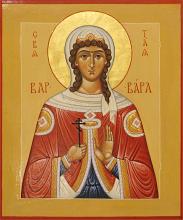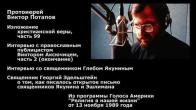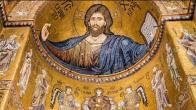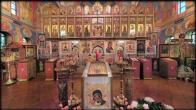You are here
Great-martyr Barbara
4/17 December
 The Holy Great-martyr Barbara lived and suffered during the reign of Emperor Maximian (305-311). Her father, a pagan named Dioscoros, was an eminent, wealthy man who lived in the town of Heliopolis in Phoenicia. Widowed early in life, he focused all of his devotion upon his only daughter. Seeing Barbara’s extraordinary beauty, Dioscoros decided to raise her out of the sight of others. To this end, he erected a tower in which only Barbara and her pagan teachers dwelt. Below the tower was spread out the length and breadth of God’s world. During the day, one could view the wooded hills, the fast-flowing rivers, and the plains, carpeted with flowers. At night, a great sea of lights presented sights of inexpressible beauty. Soon the maiden began to ask herself about the Creator and the reason behind such a harmonious and marvelous world. Gradually, she came to the firm conclusion that the lifeless idols which her father and her teachers worshipped were works of human hands, incapable of having so wisely and marvelously ordered the world around her. The desire to know the Truth of God so gripped Barbara’s soul that she decided to devote her life to it, and to spend her life in virginity.
The Holy Great-martyr Barbara lived and suffered during the reign of Emperor Maximian (305-311). Her father, a pagan named Dioscoros, was an eminent, wealthy man who lived in the town of Heliopolis in Phoenicia. Widowed early in life, he focused all of his devotion upon his only daughter. Seeing Barbara’s extraordinary beauty, Dioscoros decided to raise her out of the sight of others. To this end, he erected a tower in which only Barbara and her pagan teachers dwelt. Below the tower was spread out the length and breadth of God’s world. During the day, one could view the wooded hills, the fast-flowing rivers, and the plains, carpeted with flowers. At night, a great sea of lights presented sights of inexpressible beauty. Soon the maiden began to ask herself about the Creator and the reason behind such a harmonious and marvelous world. Gradually, she came to the firm conclusion that the lifeless idols which her father and her teachers worshipped were works of human hands, incapable of having so wisely and marvelously ordered the world around her. The desire to know the Truth of God so gripped Barbara’s soul that she decided to devote her life to it, and to spend her life in virginity.
Her beauty gained renown throughout the city, and many sought her hand. However, despite her father’s loving entreaties, she refused to marry. Barbara warned her father that his insistence might result in tragedy, separating them forever. Dioscoros decided that life in isolation had affected his daughter’s character. He allowed her to leave the tower, and allowed her total freedom in choosing her friends and acquaintances. In the city, the maiden met young confessors of the Christian Faith who taught her about the Divine Logos, Creator of the world. Some time later, by God’s Providence, a priest disguised as a merchant came to Heliopolis. He performed the rite of Holy Baptism over Barbara.
At that time, Dioscoros was having a large bathhouse built at his home. He left instructions that two windows be installed on the South side. However, in her father’s absence, Barbara arranged to have the workers install a third window, to create an image of the Triune Light. Over the entrance to the bathhouse, where Barbara described the outline of a Cross, the image became firmly impressed on the stone. A spring burst forth from the place where her footprints had landed on the steps of the bathhouse. Later it manifested great healing powers.
In his account of the holy martyr’s sufferings, Symeon Metaphrastes compared the spring to the life-giving power of the Jordan and the pool of Siloam. When Dioscoros returned and expressed dissatisfaction with the alterations made to the plan of construction, his daughter related to him her coming to know the Triune God, the salvific power of the Son of God, and the futility of idol worship. Dioscoros became angry, and unsheathed his sword to strike her. The maiden ran from her father, and he followed in pursuit. A fissure in a mountain along the way opened to hide the saint. At its other end, an opening led upward. St. Barbara managed to hide in a cave on the other side of the mountain. After a long and fruitless search for his daughter, Dioscoros saw two shepherds on the mountainside. One of them showed him the cave in which the saint had hidden herself. Dioscoros cruelly beat his daughter, locked her up under guard, and for a long time tortured her with hunger. Finally, he handed her over to Markianos, governor of the city. St. Barbara was cruelly tortured. They flogged her with rawhide whips, and abraded her wounds with a coarse hair cloth. At night, the Lord Himself visited the fervently praying saint in prison, and tended to her wounds. Later, the saint was subjected to new, even more cruel trials.
Juliana, a resident of Heliopolis and a Christian, was standing in the crowd near the place of the saint’s torture. Witnessing the beautiful and renowned maiden’s voluntary martyrdom, her heart overflowed with compassion. Wanting to suffer for Christ as well, she began to loudly denounce the torturers. She was taken. The holy martyrs were subjected to lengthy trials: Their flesh was ripped with iron hooks, their breasts were severed, and they were led naked throughout the city, to be subjected to ridicule and beatings. Heeding St. Barbara’s prayers, the Lord sent an angel, who covered the naked saints with glistening garments. Resolute confessors of the Christian Faith, Sts. Barbara and Juliana were beheaded. Dioscoros himself put Barbara to death. God’s retribution fell quickly upon Markianos and Dioscoros; both were consumed by lightning.
In the 6th Century, the relics of the Saint were translated to Constantinople. In the 12th Century, Princess Barbara, daughter of the Byzantine Emperor Alexis Comnenos (1081-1118) married the Russian Prince Michael Izyaslavitch, and brought the relics with her to Kiev. They rest in the Cathedral of St. Vladimir to this day.
Relics in cathedral - monthly calendar
| S | M | T | W | T | F | S |
|---|---|---|---|---|---|---|
|
|
|
|
1
|
2
|
3
|
4
|
|
5
|
6
|
7
|
8
|
9
|
10
|
11
|
|
12
|
13
|
14
|
15
|
16
|
17
|
18
|
|
19
|
20
|
21
|
22
|
23
|
24
|
25
|
|
26
|
27
|
28
|
29
|
30
|
31
|
|
PARISH LIFE
Address of our Cathedral
While all the materials on this site are copyrighted, you may use them freely as long as you treat them
with respect and provide attribution on the Russian Orthodox Cathedral of St.John the Baptist of Washington DC.









